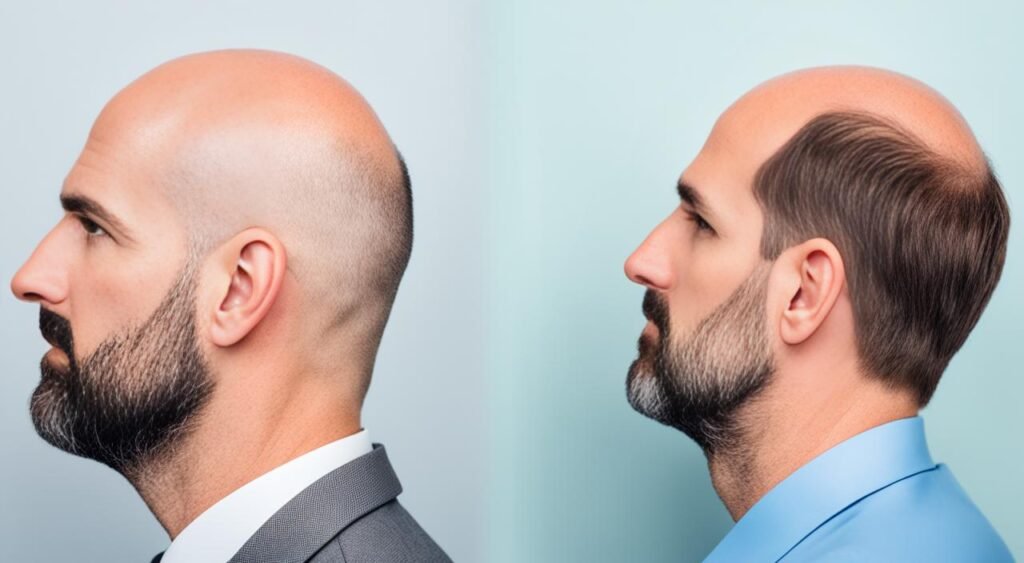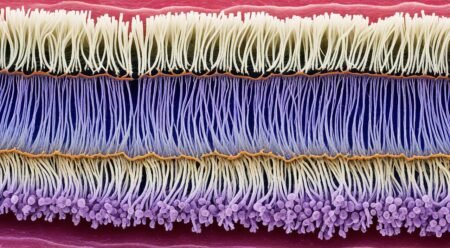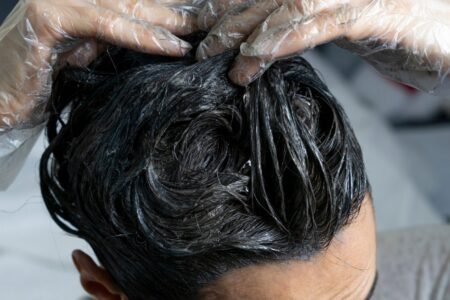“The best investment is in the tools of one’s own trade.” Coming from the immortal words of Benjamin Franklin, this adage couldn’t ring more true when considering the investment you might be making in 2023 – an investment in yourself. As discussions about personal improvement become ever more prevalent, you or someone you know may be exploring the prospect of a hair transplant. How much does a hair transplant cost? What factors into the 2023 hair restoration cost?
In this rapidly evolving field of aesthetic beauty and personal care, understanding the hair transplant cost is paramount before embarking on the journey to reclaim not just your hairline but also your self-esteem and confidence. This guide will arm you with indispensable knowledge and realistic expectations as you navigate through the intricacies of hair restoration costs this year.
Whether it’s your first foray into the world of hair transplants or you’re well-acquainted with the topic, this article will dive deep into what drives these costs and offer you a clear picture that aligns with your personal goals. Let’s uncover the facts and figures that will help you make an informed decision on this life-enhancing procedure.
Understanding Hair Transplant Surgery and Methods
As you navigate the journey towards hair restoration, grasping the basics of hair transplant surgery is crucial. This technique serves as a beacon of hope, promising to rejuvenate your look and confidence by replenishing areas marred by hair loss. In essence, a hair transplant moves hair you already have to fill an area with thin or no hair. Let’s delve deeper into the particulars of this treatment and what it entails for the hair restoration cost and the cost of hair transplant surgery.
What is a Hair Transplant?
At its core, a hair transplant is a procedure by which a dermatological surgeon transplants hair to a bald area of the head. The surgeon typically moves hair from the back or side of the head to the front or top. This process not only seeks to restore growth but also ensures that the results blend seamlessly with your natural hair pattern, creating a virtually undetectable finish. Considering the customized nature of the procedure, the cost of hair transplant surgery can be quite variable.
Differences Between FUT and FUE Techniques
With two primary methods for hair transplantation available—Follicular Unit Transplantation (FUT) and Follicular Unit Extraction (FUE)—each patient’s experience and investment can differ. FUT involves removing a strip of skin from the donor area and extracting individual follicular units which are then transplanted to the target area. On the other hand, FUE entails the direct extraction of individual hair follicles from the donor site which are then individually transplanted.
- FUT: Ideal for extensive hair loss, longer recovery, potentially more cost-effective for larger sessions.
- FUE: Less invasive, shorter recovery time, cost per graft may be higher, but scars are less noticeable.
The choice between FUT and FUE affects not just the physical aspects of recovery, but also the hair restoration cost, with each technique requiring different levels of time and resources.
Advancements in Hair Transplant Technology
As medical technologies progress, so do the opportunities for more effective and efficient hair transplants. Innovations like robotic hair restoration systems and laser therapies are being integrated into practices, potentially increasing the precision and success rates of procedures. Advanced methods may come with different pricing structures, influencing the cost of hair transplant surgery.
Ultimately, keeping abreast of the latest technologies and their implications on pricing will help you make an informed decision that aligns with your hair restoration goals and budget.
Factors Affecting the Cost of Hair Transplant Surgery
When considering a hair transplant, the variance in cost can be puzzling. To help you navigate the hair transplant cost estimate, it’s crucial to understand the factors that weigh heavily on the final price. The availability of donor hair, clinic location, and the surgeon’s expertise all play a pivotal role in determining hair transplant cost.
The Role of Donor Hair Availability
The quantity and quality of your donor hair are of utmost importance in a hair transplant. Abundant, healthy donor hair simplifies the procedure and may reduce the time and resources required. In contrast, limited or poor-quality donor hair can complicate the surgery, potentially leading to a longer procedure or the need for additional sessions, which can drive up costs.
Impact of Clinic Location on Pricing
Clinic location significantly influences the costs. Urban centers and high-cost living areas are associated with higher prices due to larger overheads. Your choice of clinic location is hence intertwined with the overall pricing you can expect for your hair restoration journey.
The Surgeon’s Expertise and Reputation
The skill level and reputation of the surgeon carry a premium. Surgeons who are at the top of their field and carry high success rates can command greater fees, often correlating with a higher standard of care and results. Opting for a renowned surgeon can escalate the cost but is an investment in the quality and longevity of your hair transplant results.
In your quest for determining hair transplant cost, it’s essential to arm yourself with a thorough knowledge of these key factors. Your individual needs and expectations will ultimately guide the financial blueprint of your hair restoration plan.
| Factor | Impact on Cost |
|---|---|
| Donor Hair Availability | More available, healthy hair can reduce costs, while scarcity can increase them |
| Clinic Location | Urban and high-cost areas typically see higher hair transplant prices |
| Surgeon’s Expertise | Top-tier surgeons often charge more, reflecting their experience and successful track record |
Understanding the intricate details of these aspects can serve as a solid foundation as you prepare your personalized hair transplant cost estimate.
How Much Does a Hair Transplant Cost?
When considering a hair transplant, one of the first questions you might have is about the average cost of a hair transplant. Deciding to undergo this life-changing procedure isn’t just about the physical transformation; it’s also about understanding the financial commitment. In 2023, the cost of hair transplants can vary widely, influenced by multiple factors such as the technique used, the extent of the treatment area, and the geographic location of the clinic.
So, what kind of numbers are we talking about? The average cost can range from a few thousand to tens of thousands of dollars. Here’s a more detailed look into the pricing that can help you gauge the investment needed for your specific situation:
| Hair Transplant Technique | Low End Cost Estimate | High End Cost Estimate |
|---|---|---|
| FUT (Follicular Unit Transplantation) | $4,000 | $8,000 |
| FUE (Follicular Unit Extraction) | $6,000 | $15,000+ |
It’s crucial to understand that these figures are estimates, and the actual cost of a hair transplant is highly personalized. The density of the donor hair, your scalp’s characteristics, and the desired outcome all play a part in the final cost. Additionally, the surgeon’s expertise can either hike up the price or give you more value for your money. Premium clinics often come with a heavier price tag, but they may offer advanced technology and a highly experienced medical team.
Remember, while the sticker price is important, the quality of the results should be a significant factor in your decision-making process. Always consult with qualified professionals for a personalized quotation to get an accurate picture of your hair transplant investment.
Breaking Down Hair Transplant Cost Per Graft
Understanding the hair transplant cost per graft is crucial when considering a hair restoration procedure. A graft is typically a small section of tissue containing hair follicles that is transferred from a donor area to the balding part of the scalp. Since the total cost of a hair transplant is often based on the number of these grafts that your specific condition requires, grasping this concept is vital for your financial planning.
The average cost per graft can vary significantly depending on factors such as the clinic’s location, the expertise of the surgeon, and the transplantation method used. However, knowing the average expense is a stepping stone to anticipating the overall financial investment of your hair transplant journey. To illustrate, a detailed breakdown table is below that shows how the total costs can accumulate based on different graft quantities:
| Number of Grafts | Average Cost Per Graft | Estimated Total Cost |
|---|---|---|
| 500 | $3 | $1,500 |
| 1,000 | $4 | $4,000 |
| 1,500 | $4.50 | $6,750 |
| 2,000 | $5 | $10,000 |
| 2,500 | $5.50 | $13,750 |
Please note that these figures are estimates and can differ based on the aforementioned factors. The correlation between the number of grafts and the final expense of a hair transplant is clear from the table; the more grafts needed, the higher the overall cost will be. A thorough consultation with your hair restoration specialist will provide a more personalized and accurate cost estimation based on the number of grafts suitable for your hair loss pattern.
It’s essential to approach the cost per graft with a critical eye, considering both the price and the quality of care you will receive. Lower costs may not always equate to a successful outcome if it compromises the level of expertise and post-operative care. Investing in a reputable and experienced surgeon often ensures enhanced results and can be the most cost-effective choice in the long run.
The Influence of Treatment Area Size on Hair Transplant Price
As you consider restoring your hair’s former glory, understanding how the size of the area requiring treatment directly influences the hair transplant cost is crucial. A larger area of baldness doesn’t just mean more grafts; it also impacts the hair transplant price itself, both in terms of procedure time and the resources needed to achieve a seamless, natural-looking result.
Understanding Graft Quantities for Different Balding Patterns
The number of grafts you’ll need varies significantly based on the extent and pattern of hair loss. For instance, a receding hairline might require fewer grafts than a larger bald spot on the crown. Each graft contains 1-4 hairs, and it’s this fine blend of science and art that makes hair restoration so personalized—and variable in cost.
Calculating the Cost for Full Head vs. Partial Hair Restoration
If you’re facing a full head restoration, the graft numbers—and corresponding prices—will undoubtedly be higher. However, partial hair restoration for thinning areas doesn’t always come cheap either. The final price tag threads together professional evaluations, the complexity of the restoration, and the total graft counts needed for a natural finish.
Here’s a simplified breakdown to help you understand the potential costs:
- Partial hair restoration: Targets specific areas and may range between a few hundred to a couple thousand grafts based on the thinning severity.
- Full head restoration: Requires an extensive number of grafts, often going up to several thousand, to cover large bald patches or complete baldness.
As you navigate through the pricing landscape of hair transplantation, keep in mind that a detailed consultation with a qualified hair restoration specialist remains the best way to receive an accurate estimate tailored specifically to your needs and expected outcomes.
Average Cost of Hair Transplant Across the Globe
When considering a hair transplant, you may notice that the average cost of hair transplant can vary significantly from one country to another. Understanding these differences is crucial as they’re influenced by different economic conditions, healthcare systems, and standards of living around the world. It’s not just about the number of follicles being moved; it’s also about where you choose to have the procedure done. Here’s an enlightening look at the hair transplant cost on an international scale.

Below is a comprehensive table that compares the approximate cost of hair transplant surgeries in various countries around the globe. As you look at these figures, keep in mind that the cost can be impacted by the specific clinic, the technology used, and the surgeon’s expertise in each location.
| Country | Average Cost (USD) | Cost Range (USD) |
|---|---|---|
| United States | $8,000 | $4,000 – $15,000 |
| Canada | $7,000 | $5,000 – $14,000 |
| United Kingdom | £4,000 | £2,500 – £10,000 |
| Australia | A$10,000 | A$6,000 – A$20,000 |
| India | ₹1,20,000 | ₹50,000 – ₹3,00,000 |
| Turkey | $2,500 | $1,500 – $4,000 |
| Brazil | R$15,000 | R$7,000 – R$25,000 |
| South Korea | ₩7,000,000 | ₩3,500,000 – ₩10,000,000 |
Note that the prices above are subject to change and only give a general idea of the hair transplant cost in respective locations. Potential patients should also consider other factors like travel expenses, accommodation, and the credential checks of overseas clinics and surgeons when planning a hair transplant abroad. Engaging in thorough research and obtaining detailed consultations with chosen clinics will help you make an informed decision that aligns with both your hair restoration goals and your budget.
Preparing for the Financial Investment of a Hair Transplant
Embarking on the journey of hair restoration is not only a commitment to your physical appearance but also a significant financial decision. Understanding the hair restoration cost and exploring a hair transplant cost estimate are vital steps in preparing for this transformative procedure. It’s essential to review your financial plan and assess the different avenues available to ensure that this investment does not become a burden.
Evaluating Financing Options and Payment Plans
Most clinics understand that the cost of a hair transplant can be a substantial outlay for many. As a result, many offer financing options and payment plans to help spread the expense over a period of time. These might include in-house financing, credit services specialized in medical expenses, or third-party lenders. It is important to review the terms and conditions of these plans carefully, comparing interest rates and monthly instalments, to choose an option that best suits your financial situation.
Considering the Long-Term Value of Hair Restoration
A hair transplant is an investment in yourself, and when considering the cost, it’s equally important to reflect on the long-term value it brings to your life. Successful hair restoration can offer a permanent solution to hair loss, boosting confidence and potentially leading to greater personal and professional opportunities. The upfront costs might seem daunting, but the lifelong benefits often outweigh these initial expenses.
- Increased self-esteem: A full head of hair often improves self-perception and confidence
- Reduction in long-term hair maintenance costs: Over time, a permanent hair transplant may cost less than ongoing temporary treatments
- One-time investment: Unlike other treatments that require continuous expense, a hair transplant is typically a one-off cost
In front of you, you may find an image that captures the transformative effects of a hair transplant, symbolizing the potential benefits that await.
As you gather information and contemplate the financial aspects of hair restoration, remember that the journey is deeply personal. Your sense of self and wellbeing are priceless, and investing in your hair can be a life-changing decision. With careful planning and a clear understanding of the costs involved, you can proceed confidently, knowing that the value of a full head of hair extends far beyond the numbers in your bank account.
Insurance and Hair Transplants: What’s Covered?
As you navigate the complexities of hair restoration cost, understanding the role of insurance in offsetting the hair transplant cost is crucial. Typically, hair transplants are considered cosmetic procedures, but there are exceptions where coverage might be possible. Below, we’ve broken down common insurance policy stances on hair restoration procedures.
Please note, insurance policies vary greatly by provider and plan, so it remains imperative for you to scrutinize the specifics of your coverage. The information provided here serves as a general guideline.
| Insurance Scenario | Covered | Not Covered |
|---|---|---|
| Elective/Cosmetic Hair Transplants | Not Typically | Most Plans |
| Medically Necessary Procedures (e.g., due to injury) | Some Plans | Varies |
| Partial Coverage (Consultation, certain tests) | Possible with Some Plans | Most Procedures |
| Hair Loss Due to Medical Conditions | Occasionally (with Documentation) | Common |
Bear in mind these scenarios—if your hair loss is the result of an accident, a medical condition, or a prescribed medication, there may be openings for partial or full coverage. Still, the decision is ultimately at the discretion of the insurance provider and often involves a rigorous claim process, requiring substantial medical evidence.
Without coverage, the hair restoration cost can become a significant financial consideration. Inquire directly with your insurance provider to get the most accurate understanding of where you stand. No matter your situation, thorough research will empower you to make the most informed decision as you explore the path to hair restoration.
Additional Expenses to Consider in Hair Transplant Cost Estimate
While many people focus solely on the hair transplant price of the procedure itself, it’s crucial to factor in the ancillary costs that can accrue. These often-unexpected expenses play a vital role in the overall financial planning of your hair restoration journey.
Post-Surgery Care and Maintenance Costs
After your hair transplant procedure, specialized shampoos, conditioners, and serums may be recommended to ensure optimal healing and hair growth, leading to additional costs. Not to neglect are follow-up consultations and potentially prescribed medications to mitigate any chance of infections or to stimulate hair growth. These items, while essential for the postoperative care, add another layer to your hair transplant cost estimate.
Travel Expenses for Out-of-Town Patients
Choosing a high-quality surgical center or renowned specialist might necessitate travel. Consequently, transportation, accommodation, and meal expenses must be considered for both the initial surgery and any subsequent follow-ups. Even local travel costs can add up if multiple visits are necessary. Prepare to adjust your budget to accommodate these potential travel expenditures for a more accurate reflection of the total hair transplant price.

| Expense Category | Typical Cost Range | Notes |
|---|---|---|
| Post-Surgery Products | $50 – $200 | Varies by brand and region |
| Medications | $20 – $100 | Costs may be covered by insurance |
| Follow-up Consultations | $100 – $300 per visit | Dependent on specialist fees |
| Travel and Accommodations | $100 – $1000+ | Based on distance and duration of stay |
By meticulously adding these extra expenses to your budget, you ensure a more comprehensive and less surprising hair transplant cost estimate. It’s always better to overestimate these costs rather than be caught unprepared; think of it as an investment in the success of your hair restoration process.
Potential Risks and Their Impact on Hair Transplant Costs
When considering a hair transplant, it’s vital for you to understand that, like any surgical procedure, there are inherent risks and potential complications that can not only affect your health but also have financial repercussions. Unexpected issues may arise, potentially inflating the cost of hair transplant surgery beyond initial estimates.
Complications that Can Affect Cost
Complications during or after a hair transplant procedure can lead to increased medical expenses. These complications might include infections, excessive bleeding, or adverse reactions to anesthesia. Each of these issues can require additional treatment or medication, accruing further costs. Additionally, if the healing process is prolonged, you might also encounter loss of income due to extended recovery time off work. It’s essential to factor in these potential costs when budgeting for your hair transplant.
Dealing with Unsatisfactory Results and Revision Surgeries
Occasionally, hair transplant results may not meet your expectations, or you might experience unforeseen issues such as uneven hair growth or scarring. In such cases, revision surgeries may be necessary. These additional procedures can significantly increase the hair transplant cost per graft, amplifying your total expenditure. When planning for your hair transplant, it’s important to consider the possibility of needing additional procedures and include them in your financial planning.
| Potential Risk | Additional Cost Factor | Preventative Measures |
|---|---|---|
| Infection | Medications, further doctor visits | Choosing a reputable clinic and following post-op care instructions precisely |
| Excessive Bleeding | Possibly extended hospital stay | Detailed pre-op consultation to assess bleeding risk factors |
| Adverse Reaction to Anesthesia | Emergency care, additional monitoring | Assessment of allergies and prior reactions to anesthesia |
| Unsatisfactory Growth | Correction surgeries, additional grafts | Selecting an experienced surgeon to minimize the risk |
| Scarring | Cosmetic treatments, scar revision surgeries | Discussing technique with your surgeon to select the least invasive option |
It is crucial to discuss all aspects of the procedure, including the potential risks and their financial implications, with your hair transplant surgeon. Doing so will give you a clearer understanding and help you set realistic expectations for the cost of hair transplant surgery.
By acknowledging these risks and planning accordingly, you can ensure that you’re prepared for any additional costs that might arise, safeguarding both your physical and financial wellbeing.
Determining Hair Transplant Cost: Personalized Consultation Insights
Embarking on your hair restoration journey presents a range of factors to consider, but most pivotal to your planning will undoubtedly be determining how much a hair transplant will cost you personally. A bespoke consultation with a hair transplant specialist is the cornerstone to understanding the specific financial commitment required for your situation. Such customized engagements provide valuable insights, taking into account the unique characteristics of your hair loss, desired results, and the particular methodologies suited to you.
Throughout our discussion, we’ve traversed the landscape of hair transplant costs, analyzing the multifaceted elements that contribute to the overall pricing structure. From the significance of graft numbers to the influence of geographical clinic locations, the complexity of crafting an accurate cost estimate is clear. As you’ve learned, the surgeon’s expertise, technology advancements, and even additional post-surgery care are just a few of the components that will form the final tally of your procedure.
With this rich tapestry of information, your personalized consultation acts as a clarifying session, designed to weave together these diverse strands into a coherent pricing portrait for your hair transplant. It is here, in the nuanced discussion with a seasoned professional, that you will uncover a detailed and tailored cost assessment. Remember, while online estimates can offer a ballpark figure, the precision of **determining a hair transplant cost** tailored to your unique needs can only truly be grasped through a consultation that respects the individuality of your hair restoration needs and goals.










